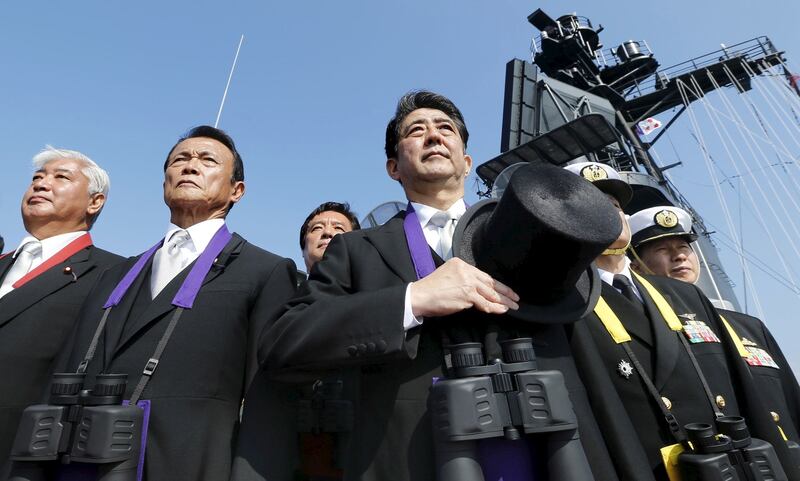Naval ships from Japan and the United States have conducted their first ever anti-submarine warfare exercise in the South China Sea, the Japan Maritime Self-Defense Force said, as Tokyo steps up joint maritime activities in those disputed waters with Western and Southeast Asian partners.
The deployment of Japanese ships and planes to the region, while seen as in line with Japan’s maritime strategy toward Southeast Asia, will no doubt meet with protests from China, which claims most of the South China Sea.
A statement from the JMSDF said the helicopter destroyer JS Kaga, destroyer JS Murasame, a P-1 maritime patrol aircraft and an unnamed submarine took part in the drill Tuesday with the U.S. Navy's USS Milius and a P-8A maritime patrol aircraft. It did not reveal the exact location of the exercise.
The Japan Maritime Self-Defense Force (JMSDF), or the Japanese Navy as it’s commonly known, said in the statement: “In this exercise, the JMSDF submarine conducted (an) anti-submarine warfare exercise with the U.S. Navy in the South China Sea for the first time, further improving our tactical skills and interoperability between the JMSDF and the U.S. Navy.”
The Japanese ships, together with four helicopters, an Oyashio-class submarine and a maritime patrol aircraft, are part of the JMSDF’s Indo-Pacific Deployment 2021 (IPD21) task group formed to highlight Tokyo’s interest and commitment in a “free and open” Indo-Pacific, as well as Japan’s cooperation with other navies in the region, according to Japanese defense officials.
The IPD21 started in late August and the ships are scheduled to return to Japan by Nov. 25.
Before the anti-submarine exercise, on Nov. 14 the JS Kaga and JS Murasame conducted a bilateral exercise with the Philippine Navy frigate BRP Joze Rizal after a port call to Subic in the Philippines.

Major policy shift
The two destroyers also made a port call in Cam Ranh Bay in central Vietnam on Nov. 5-7 and took part in a goodwill exercise with the Vietnamese Navy’s Gepard-class frigate Dinh Tien Hoang.
During the second half of November, there will be more bilateral and multilateral exercises, according to the JMSDF. Most notably, from Nov. 21 to 30 in the waters around Japan, two multilateral exercises will be conducted with the JMSDF, the U.S. Navy, the Royal Australian Navy, the German Navy, and the Royal Canadian Navy.
A total of 20 JMSDF ships and 40 JMSDF aircraft, 10 U.S. Navy ships, two Australian Navy ships, a Canadian ship and a German Navy ship will take part in these drills.
Japan -- whose military activity is constrained by its post-World War II pacifist constitution -- introduced a major security policy shift under the government of former Prime Minister Shinzo Abe. Since then, the Japanese Navy has expanded its presence and joint maritime activities in the South China Sea in order to promote a regional ‘rules-based order’.
“Japan has greatly increased its ability to project its maritime power and shrugged off longstanding taboos on security policy in doing so. Geopolitically it is a response to a heightened perception of risk due to China’s military modernization program and regional hegemonic ambitions,” Jeff Kingston, director of Asian studies and a professor at Temple University in Tokyo said in an earlier interview with RFA.
“Japan participates in the Quad (grouping between the U.S., India, Japan and Australia) and has been an advocate of a free and open Indo-Pacific, a concept aimed at containing the expansion of China's regional influence that involves, among other things, joint naval exercises,” Kingston said.
Experts say the South China Sea is now playing an important part in Japan’s maritime strategy where Tokyo is taking a multilateral approach to pushing back on Chinese territorial claims.
Capacity building
According to the Center for Strategic and International Studies (CSIS), more than 40 percent of Japan’s maritime trade passes through the South China Sea.
China's growing assertiveness against other claimant states in the South China Sea, and Japan in the East China Sea "presents another grave concern for Japan," said a new report by the ISEAS-Yusof Ishak Institute in Singapore.
“Japan has traditionally been a provider of maritime capacity-building assistance for Southeast Asian states, offering activities ranging from joint exercises, training opportunities in Japan for defense personnel to equipment transfer,” said the report.
Vietnam and the Philippines, "the nations that straddle the north section of the South China Sea, and flank the important PRC submarine base on Hainan Island" have become important maritime security partners for Japan, wrote John Bradford, executive director of the Yokosuka Council on Asia Pacific Studies, on the Center for International Maritime Security website.
Bradford added that “the JMSDF’s relationship with the Philippine Navy is the most developed of its Southeast Asia partnerships.”
According to the Japanese Ministry of Foreign Affairs, the JMSDF has provided 12 patrol vessels, 13 high-speed boats, a coast monitoring radar system and training to the Philippine Navy. To Vietnam, it transferred six patrol vessels and seven used vessels together with related equipment.
Japan is carrying out a large number of capacity-building projects in countries in the South China Sea as “Southeast Asia has clearly become a new nexus in Japan’s maritime strategy,” noted Bradford.
